“Go Back To Where You Came From”
Amos, The Unwanted Prophet: Part Four
The one institution in Israel most severely affected by this loss of integrity was “the gate”. “The gate” referred to is the place of entry and exit to a walled village or city where the elders of that city gathered periodically to make decisions or dispense justice. It was in these meetings at the gate that the need of the weak and poor were heard and defended against the whims of the wealthy and powerful.
The new king of Israel had recognized that his people would continue to look to Jerusalem as their religious center and as the place where major sacrifices were to be made. Thus, Jeroboam initiated a series of religious reforms to provide alternative worship centers for his people and turn their allegiance to his regime. Although these reforms made good political sense at the time, they became the basis for the subsequent criticism of Israel and of those kings who continued to promote the sins of Jeroboam. Now over a century later, Amos, a man of Judah, stands before an audience of Israelites at Bethel and challenges them to repent and reject not only Jeroboam’s sin but also the royal shrine that serves a focal point and an economic engine among them (V. H. Matthews, The Hebrew Prophets and their Social World, 2012, p. 83).
“Father, Father!” Joshua shook his father, Amos. “Are you OK?”
“Yes, son,” Amos replied, trying to collect his thoughts.
“Another dream?” Joshua asked a little frightened, realizing how much he depended on this father.
“Yes,” Amos responded, “Another vision,” he emphasized. “I saw a basket of rotting fruit.”
“That doesn’t sound too bad,” Joshua said a little confused.
“I realized that the basket of rotting fruit was our Northern brothers, Israel,” Amos said slowly and clearly, “but I was made to know that this rotting fruit was ripe for destruction.” Amos clearly emphasized the last part, ‘ripe for destruction.’
He continued, “In the vision the shadowy figure of Yahweh himself was seen already at work destroying a temple and slaughtering its visitant!”
“So, father, we are too late,” Joshua said frightened.
“Yes and no,” Amos replied. His son looked confused. “These visions show both what is happening and what will happen.” Joshua still looked confused. “As I have learned from past visions,” Amos carefully explained, “the Lord God can relent with carrying out the vision.”
“So, there is time,” Joshua said hopefully.
“Yes,” Amos simply replied. “But I do not believe that our Northern brothers will change, especially when someone from the South delivers the message.”
“Is that why Yahweh has picked you,” Joshua hinted, “because he wants to destroy the North?”
“Son,” Amos replied, “we always have to believe that the Lord God wishes the best for us, especially the poor, the anawim, that are trapped in even God’s punishment on the rich and unjust.”
“What do we do now,” Joshua asked.
“We deliver the message,” was all Amos could answer. “And then we wait.”
The next day, after Amos had delivered his message, they were on their way back to Tekoa.
“We delivered the message,” Amos said.
“Father, you were wonderful,” Joshua reassured him. “They were cheering you on for a while.”
“That is because they didn’t know where it was heading,” Amos smiled.
“They left, one by one,” Joshua added with disappointment.
Amos begins to repeat the litany like cadence that he had used for the other nations, only this time for Israel.
“For bribery and injustice toward the poor,” Amos intoned.
“Death and destruction,” Josua answered.
“For good people being sold into slavery,” Amos said.
“Exile of survivors,” Joshua added.
“For visits to the temple prostitutes,” Amos continued.
“Destruction of altars at Bethel and Dan,” Joshua answered.
“For idol worship,” Amos shouted.
“Bethel destroyed,” Joshua shouted.
“Abuse of the Nazirites,” Amos shouted all the more.
“Death and destruction,” Joshua screamed.
“For silencing the prophets,” Amos said quietly.
“Yahweh’s punishment will be carried out,” Joshua fatefully said.
Go Back To Where You Came From pt 4
Go Back To Where You Came From pt 3
Go Back To Where You Came From pt 2
Go Back To Where You Came From pt 1
AMOS Intro

